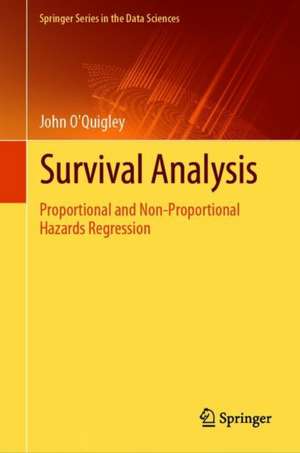Survival Analysis: Proportional and Non-Proportional Hazards Regression
Autor John O'Quigleyen Limba Engleză Hardback – 27 apr 2021
The intended audience includes academic statisticians, biostatisticians, epidemiologists and also researchers in these fields whose focus may be more on the applications than on the theory. The text could provide the basis for a two semester course on survival analysis and, with this goal in mind, each chapter includes a section with a range of exercises as a teaching aid for instructors.
| Toate formatele și edițiile | Preț | Express |
|---|---|---|
| Paperback (1) | 453.69 lei 38-44 zile | |
| Springer International Publishing – 28 apr 2022 | 453.69 lei 38-44 zile | |
| Hardback (1) | 466.63 lei 38-44 zile | |
| Springer International Publishing – 27 apr 2021 | 466.63 lei 38-44 zile |
Preț: 466.63 lei
Nou
Puncte Express: 700
Preț estimativ în valută:
89.29€ • 93.22$ • 73.90£
89.29€ • 93.22$ • 73.90£
Carte tipărită la comandă
Livrare economică 01-07 aprilie
Preluare comenzi: 021 569.72.76
Specificații
ISBN-13: 9783030334383
ISBN-10: 3030334384
Pagini: 475
Ilustrații: XVI, 475 p. 60 illus., 13 illus. in color.
Dimensiuni: 155 x 235 mm
Greutate: 0.95 kg
Ediția:1st ed. 2021
Editura: Springer International Publishing
Colecția Springer
Locul publicării:Cham, Switzerland
ISBN-10: 3030334384
Pagini: 475
Ilustrații: XVI, 475 p. 60 illus., 13 illus. in color.
Dimensiuni: 155 x 235 mm
Greutate: 0.95 kg
Ediția:1st ed. 2021
Editura: Springer International Publishing
Colecția Springer
Locul publicării:Cham, Switzerland
Cuprins
Introduction.- Survival analysis.- Survival without covariates.- Proportional hazards models.- Proportional hazards models in epidemiology.- Non-proportional hazards models.- Estimating equations.- Survival given covariate information.- Regression effect process.- Model construction guided by regression effect process.- Hypothesis tests.
Notă biografică
John O’Quigley is professor of statistics in the Department of Statistical Science, University College London. Professor O'Quigley's academic career began as MRC research scientist at the University of Leeds, U.K., a stint followed by several positions in France, the most recent being in the Laboratory of Probability, Statistics and Modelling, University of Paris – Sorbonne. The most significant part of Professor O’Quigley’s career has been spent in the United States, mainly in the Department of Mathematics, University of California San Diego during which time he was a tenured full professor of mathematics. He was also Director of the Laboratory for Mathematics and Statistics. Prior to that Professor O’Quigley was a researcher at the Fred Hutchinson Cancer Research Center and the Department of Biostatistics, University of Washington, Seattle. Several years were also spent as full professor at the University of Virginia Medical School as well as the Department of Mathematics at Lancaster University, U.K.
Textul de pe ultima copertă
This book provides an extensive coverage of the methodology of survival analysis, ranging from introductory level material to deeper more advanced topics. The framework is that of proportional and non-proportional hazards models; a structure that is broad enough to enable the recovery of a large number of established results as well as to open the way to many new developments. The emphasis is on concepts and guiding principles, logical and graphical. Formal proofs of theorems, propositions and lemmas are gathered together at the end of each chapter separate from the main presentation.
The intended audience includes academic statisticians, biostatisticians, epidemiologists and also researchers in these fields whose focus may be more on the applications than on the theory. The text could provide the basis for a two semester course on survival analysis and, with this goal in mind, each chapter includes a section with a range of exercises as a teaching aid for instructors.
The intended audience includes academic statisticians, biostatisticians, epidemiologists and also researchers in these fields whose focus may be more on the applications than on the theory. The text could provide the basis for a two semester course on survival analysis and, with this goal in mind, each chapter includes a section with a range of exercises as a teaching aid for instructors.
Caracteristici
Summaries and exercises included in every chapter Extensive appendices provided on probability, stochastic processes, and simulating data Many of the advances of the last ten years, not covered elsewhere, are given prominence in this book
